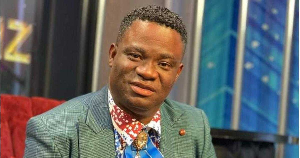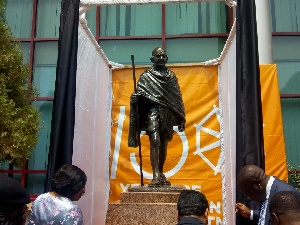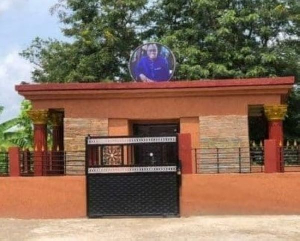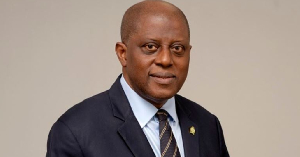I was very fortunate this morning (6th April 2019) to have had the privilege of joining my group, after a meeting in Johannesburg, to go on a tour of Constitution Hill.
Constitution Hill is known for hosting the Constitutional Court of South Africa. It is built on grounds that were previously home of one of South Africa’s most notorious prisons, used to hold more than 2000 mainly black prisoners at a time.
It hosted people of other races too. It had been designed for a maximum of 600 people. I learned about the fact that 1 in 8 black men living in Johannesburg around 1920-30 spent some time there, simply for being black.
They probably did not carry a pass that allowed them into some parts of the city. Women and children were also detained there. Nelson Mandela was held there on two occasions before being finally transferred to Robben Island. It also hosted Mahatma Gandhi.
I learned a lot about the place and its notoriety from the tour guide and the short documentary we were shown at the beginning of the tour. South Africans are very proud of the fact that Constitution Hill reflects its very turbulent past and also its aspirations for the future as symbolized by the new Constitutional Court building.
Despite the many horrible things I learned about the infamous prison and some of its famous ‘guests’, what has stayed with me the most is the fact that Gandhi and Mandela shared something in common.
For whatever it is worth, they had stayed at the same horrible place, even if at different points in time. They shared the pain and indignity that all the prisoners went through on a daily basis. I was drawn to the exhibition that had been mounted there to celebrate the two former inmates.
I saw a write-up on the wall that extolled the virtues of the two men, drawing attention to what they had in common. Mandela is quoted as saying “The spirit of Gandhi may well be a key to human survival in the 21st Century”.
Mahatma Gandhi is also reported to have said, “It was after I went to South Africa that I became what I am now”. As I read the remarks that Mandela made about Gandhi, emphasizing how inspired he was by the life of Gandhi, I couldn’t helping asking myself “Didn’t Mandela know that Gandhi was racist?”
Nelson Mandela had spent 27 years of his life in prison fighting to prove that the black man was as good as the white man, and yet could not see racism in Gandhi? A number of academics at University of Ghana, on the other hand, had all the evidence about how racist Gandhi was.
As I pondered over why Mandela did not see Gandhi as racist, my mind took me to Atlanta, Georgia when I was there to visit friends last August. Among the many places of interest we went to in Atlanta was the Martin Luther King National Historical Park.
It is a very beautiful place that provides all the information that one needs to know about the life of the renowned civil rights leader of the US, one of the world’s greatest icons in the fight for equality by people of African ancestry.
We went to the house he grew up in and toured the rooms. We went to his church and saw the meeting rooms he used there. One thing that caught my attention was the effort made by the management of the facility to highlight the influence that Mahatma Gandhi had on Martin Luther King.
I read about how King travelled all the way to India to learn more about Gandhi and how inspired he was by this ‘man of peace’.
In Martin Luther King’s farewell statement at the end of his visit in 1959, he wrote “We think that the spirit of Gandhi is much stronger today than some people believe. There is not only the direct and indirect influence of his comrades and associates but also the organized efforts that are being made to preserve the Mahatma’s letters and other writings, the pictures, monuments, the work of the Gandhi Smark Nidhi and the movement led by the sainted Vinoba Bhave”.
King learned first hand about “passive resistance” from the writings of Gandhi. I couldn’t help wondering why he also did not find racism in Gandhi’s writings even though some Legon academics saw the evidence all over the place.
Maybe Martin Luther King did not read enough about Gandhi!
Having had these two experiences I decided that it was probably time that I wrote and spoke about my own experience at University of Ghana with Mahatma Gandhi while I was Vice-Chancellor of this great University.
I received a request in early 2016 through my Secretary, Esther that the Indian High Commissioner would like to come and see me at any convenient time.
We agreed on the time and Esther passed it on to his office. We knew each other quite well from several events that we had both participated in. When he came, he indicated that the President of India was going to pay a state visit to Ghana, and had expressed the desire to visit our University.
He told me that the President was interested in inspiring young people and so would like to give a talk on education to mainly students. I assured him that we could arrange that easily.
He went on to inform me that it was customary for the President to make a presentation to the people of any country that he went to, and traditionally this had been a statue of Mahatma Gandhi, world famous for his role as the father and architect of Indian independence in 1947.
The first thought that came to my mind was “Is the President going to carry a statue all the way from New Delhi to Accra?” I asked him that question and he said “yes”, and further assured me that they “do it all the time”. He also informed me that the visit and the gift had already been discussed and agreed with the Ministry of Foreign Affairs and the Office of the President of Ghana. We ended the meeting with me assuring him that we would think about it and get back to him.
I took a bit of time to get back to the Indian High Commissioner, largely because I was thinking about it and discussing with various colleagues the implications of such a venture at University of Ghana.
In the meantime, there were almost daily calls from the High Commissioner to find out what we had decided. There were also calls from the Ministry of Foreign Affairs wanting to know the state of affairs. I used the time to read quite a bit about Gandhi and came to understand better what he stood for.
I found a number of biographical accounts. I saw a number of articles written about him on the internet, including his life in South Africa and his return to India.
So I learned that he was 23 years old when he went to South Africa and lived there for many years. I read things attributed to him that were undoubtedly racist under any circumstance. I read how he referred to blacks as Kaffirs in some of his early writings and immediately remembered that derogatory expression from my reading of Prester John at school.
It was obvious to me that in the early days, he saw his fight to liberate Indians from oppressive laws imposed by white men, as being different from that of the struggle of the black man. I also read that he later joined hands with some black groups to resist white oppression.
As I read more and more about him, I couldn’t help seeing that the Gandhi that came to the attention of the world in the 1930s and 1940s, and gave the British Empire so much headache, was very different from the young lawyer who had arrived in South Africa a few years after leaving the UK.
I understood that Gandhi was celebrated for the things he taught the world in his later years, through his writings, ideas and lifestyle. He was celebrated for seeking peace for all the peoples of the world.
Having understood the context of Gandhi’s fame and renown, I had no difficulty in informing a meeting of the Senior Management of the University that I thought we should accept the request from the Indian High Commissioner to place a statue of Mahatma Gandhi on the campus.
Someone wanted to know why it was necessary, and I explained that the Government of Ghana was interested, and I thought it would be a good idea for our community to understand who Gandhi really was.
I remember one of my colleagues suggesting that there was no precedent of any statue being erected on the campus, and that it might be inappropriate to place the statue of a foreigner on the campus when we didn’t have any of a Ghanaian.
I also remember responding that it was not our fault that we did not have a statue of any Ghanaian, (if we excluded that of the father of one of our benefactors in front of the School of Graduate Studies); and that we could use this to develop properly our Recreational Quadrangle, erecting over time the statues of deserving persons in the expectation that our students would be inspired by their lives. I made the argument that Gandhi was a global icon and “not just an Indian”.
The meeting decided that the statue was acceptable to University of Ghana and directed that it be located at the Recreational Quadrangle behind the Balme Library.
The decision of Senior Management was conveyed to the Indian High Commissioner and the High Commission staff immediately began working with our Physical Development and Municipal Services Directorate to prepare the site for the statue.
In the meantime, we also arranged to receive the Indian President for the unveiling of the statue and a public lecture at the ISSER Conference Hall.
On the day appointed for the unveiling and lecture, the Minister of Education was tasked to represent the Government of Ghana. She arrived at my office well ahead of the Indian delegation, and suggested that we should be at the site before the delegation arrived.
I went to the Recreational Quadrangle for the event in the company of the Minister of Education. In fact, I sat in her car for the short ride. The two Pro-Vice Chancellors were also present, as indeed was the Registrar of the University.
Some Provosts and Deans attended the event. Many of the University staff and students from the nearby departments came to witness what I thought was a historic moment! It was not by any means an Ernest Aryeetey private event as has been suggested by some people.
The unveiling of the Gandhi statue by the President of India, assisted by the Minister of Education, took place, and then we proceeded to the ISSER Conference Hall for the public lecture. I reported the event subsequently to the University Council.
A couple of weeks after the event I saw on the University’s email system a mail questioning the appropriateness of having the statue of Gandhi on the campus.
The main argument in the email was that Gandhi was racist! This email was followed by the usual chorus from a few other people questioning the decision to have a Gandhi statue on the campus, having accepted that he was racist.
Rather uncharacteristically, I decided to respond, because I knew fully well how such misinformation could get out of hand. I had also experienced first-hand at University of Cape Town how the “Rhodes must fall” campaign had been hijacked by self-seekers.
I wrote a carefully crafted response on the intranet. Another major reason for my response was to indicate to the authors of the misinformation that I was ready to debate them. It was obvious that they were not used to debates, even though they were on a university campus. They were used to sending out poor opinions and no one questioning them. After my intervention the misinformation fizzled out.
Soon after I retired, the issue of Gandhi’s supposed racism was resurrected. I laughed and thought to myself, “these people were just waiting for me to go”.
In all of that, the old arguments about racism were interspersed with how I took the decision alone to place the Gandhi statue on the campus. There was the issue of how we could place the statue of a foreigner on Ghanaian soil when there were no Ghanaian statues there.
I read that the Ministry of Foreign Affairs did not know about it. A parliamentarian was quoted as saying the University did not have the capacity to make the decision about the statue. I even read that I was expecting some Indian ‘goodies’.
The main reason for writing this article is to address the issue of racism. In doing so, there is no doubt, whatsoever in my mind that, the University of Ghana had the authority to take the decision that it took at the time.
The procedures followed were legitimate and supported by the Act, the Statutes and Convention. The Government of Ghana fully endorsed the actions of the University and recognized its authority in the process.
On the issue of racism, I have come to view the experiences of Gandhi as very similar to the transformation of Saul into Paul in the Good Book. Once I accept the conversion of Paul, I can very easily forgive the early Gandhi.
The young lawyer, originally known as Mohandas Gandhi, made what I would easily describe as very racist remarks in his campaign to gain more rights for the Indian in South Africa.
He showed very little interest in the affliction of the black man and believed that the black man’s fight was different from the Indian’s. When he left South Africa and returned to India, and came face to face with the Indian caste system, he saw it as being as dehumanizing as what Indians and Blacks went through in South Africa. He found the poor Indian to be not any better off than the Indians in South Africa.
In his writings about self-government and independence, he emphasized peaceful coexistence with all races. He spent time to teach people how to resist oppression in a peaceful way.
It is this pursuit of peaceful coexistence of the races that caught the world’s respect and attention. This is what attracted Martin Luther King to his ideas. It is this same ideal that he shared with Nelson Mandela.
Indeed this is what inspired our own Kwame Nkrumah to speak about what he learned from Gandhi. Gandhi did not become a global icon for his stature or looks, but for a philosophy that most peace-loving people can associate with.
It is not for any other reason that the United Nations honoured him in 2007, adopting his birthday, 2nd October, as the “International Day of Non-Violence” It is for this reason that his statue can be found in 48 cities around the world, including more than 10 in South Africa where he had earlier called black people Kaffirs.
It is possible that the smart academics at Legon who (mis)led the campaign to have his statue brought down knew from their research something that nobody else knew. In these times of limited intellectual debates, it was easy to use social media to galvanize signatures for a misplaced petition.
When I have listened to students and some lecturers talk about Gandhi in the last year or so, I have almost always heard them say “they say he was racist”.
Unfortunately, the discerning world does not believe that! Mandela forgave his youthful over-exuberance, but a small number of Legon academics could not, and the others said nothing.
A whole nation watched as a small group of people sought to rewrite history. It is this new revisionism, based on extremely poor research and laced with bigotry, that Ghanaians should be worried about. I am done!
Ernest Aryeetey
Former Vice Chancellor and Proud Alumnus
University of Ghana
Opinions of Monday, 13 May 2019
Columnist: Prof. Ernest Aryeetey
Mahatma Gandhi and University of Ghana
Entertainment

Daddy Lumba wasn't sick for 17 years – Great Ampong
Opinions












